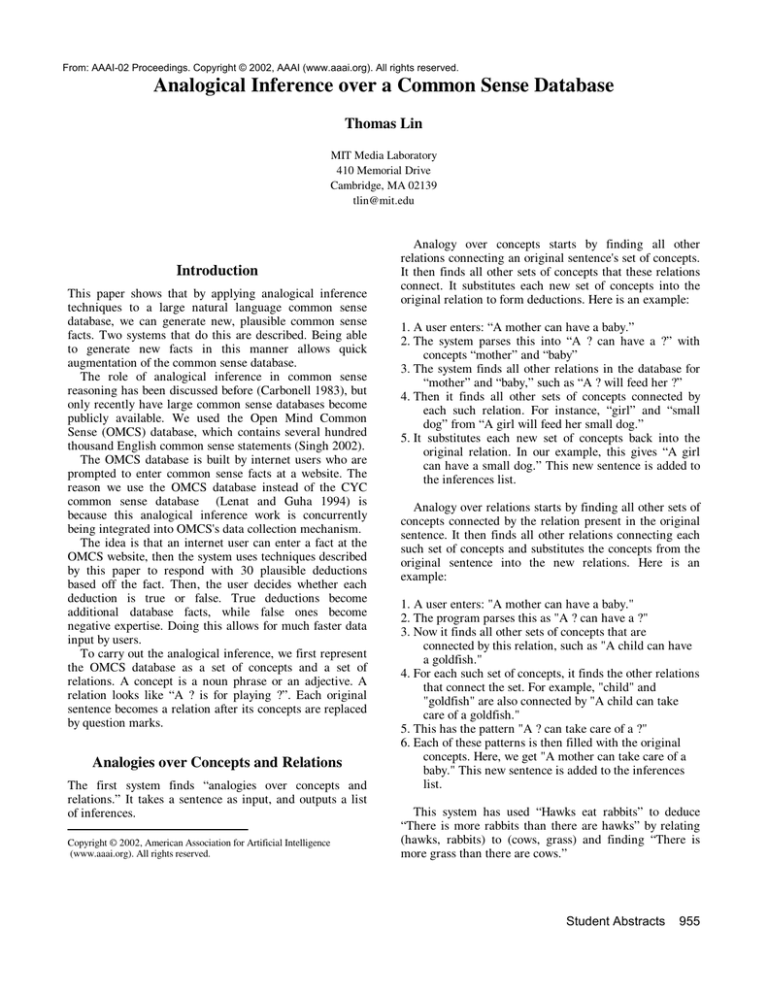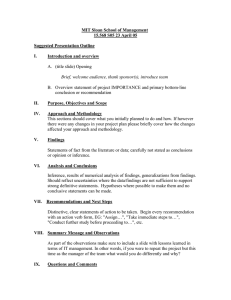
From: AAAI-02 Proceedings. Copyright © 2002, AAAI (www.aaai.org). All rights reserved.
Analogical Inference over a Common Sense Database
Thomas Lin
MIT Media Laboratory
410 Memorial Drive
Cambridge, MA 02139
tlin@mit.edu
Introduction
This paper shows that by applying analogical inference
techniques to a large natural language common sense
database, we can generate new, plausible common sense
facts. Two systems that do this are described. Being able
to generate new facts in this manner allows quick
augmentation of the common sense database.
The role of analogical inference in common sense
reasoning has been discussed before (Carbonell 1983), but
only recently have large common sense databases become
publicly available. We used the Open Mind Common
Sense (OMCS) database, which contains several hundred
thousand English common sense statements (Singh 2002).
The OMCS database is built by internet users who are
prompted to enter common sense facts at a website. The
reason we use the OMCS database instead of the CYC
common sense database (Lenat and Guha 1994) is
because this analogical inference work is concurrently
being integrated into OMCS's data collection mechanism.
The idea is that an internet user can enter a fact at the
OMCS website, then the system uses techniques described
by this paper to respond with 30 plausible deductions
based off the fact. Then, the user decides whether each
deduction is true or false. True deductions become
additional database facts, while false ones become
negative expertise. Doing this allows for much faster data
input by users.
To carry out the analogical inference, we first represent
the OMCS database as a set of concepts and a set of
relations. A concept is a noun phrase or an adjective. A
relation looks like “A ? is for playing ?”. Each original
sentence becomes a relation after its concepts are replaced
by question marks.
Analogies over Concepts and Relations
The first system finds “analogies over concepts and
relations.” It takes a sentence as input, and outputs a list
of inferences.
Copyright © 2002, American Association for Artificial Intelligence
(www.aaai.org). All rights reserved.
Analogy over concepts starts by finding all other
relations connecting an original sentence's set of concepts.
It then finds all other sets of concepts that these relations
connect. It substitutes each new set of concepts into the
original relation to form deductions. Here is an example:
1. A user enters: “A mother can have a baby.”
2. The system parses this into “A ? can have a ?” with
concepts “mother” and “baby”
3. The system finds all other relations in the database for
“mother” and “baby,” such as “A ? will feed her ?”
4. Then it finds all other sets of concepts connected by
each such relation. For instance, “girl” and “small
dog” from “A girl will feed her small dog.”
5. It substitutes each new set of concepts back into the
original relation. In our example, this gives “A girl
can have a small dog.” This new sentence is added to
the inferences list.
Analogy over relations starts by finding all other sets of
concepts connected by the relation present in the original
sentence. It then finds all other relations connecting each
such set of concepts and substitutes the concepts from the
original sentence into the new relations. Here is an
example:
1. A user enters: "A mother can have a baby."
2. The program parses this as "A ? can have a ?"
3. Now it finds all other sets of concepts that are
connected by this relation, such as "A child can have
a goldfish."
4. For each such set of concepts, it finds the other relations
that connect the set. For example, "child" and
"goldfish" are also connected by "A child can take
care of a goldfish."
5. This has the pattern "A ? can take care of a ?"
6. Each of these patterns is then filled with the original
concepts. Here, we get "A mother can take care of a
baby." This new sentence is added to the inferences
list.
This system has used “Hawks eat rabbits” to deduce
“There is more rabbits than there are hawks” by relating
(hawks, rabbits) to (cows, grass) and finding “There is
more grass than there are cows.”
Student Abstracts
955
Analogies as Inference Rules
The second system does analogical inference by
generating a list of inference rules. First, the original
database is organized into a graph where the nodes are
concepts and the edges are relations. Then, it finds all
cycles in the graph where three 2-part relations connect
three concepts. (A 2-part relation is a relation over exactly
2 variables). This could look like,
Figure 1: In this graph, “ants,” “sugar,” and “food” are
in a cycle. The three original sentences are: “You might
find ants near sugar,” “Ants like food,” and “Sugar is a
food.”
Each cycle is an inference rule. The rule here is: “(?a
like ?b) (?c is a ?b) (You might find ?a near ?b).” For each
rule, the system finds all other places in the graph where
any two of the three elements in the inference rule are
instantiated. It then forms what a third element needs to
look like to be consistent with the first two, and presents it
as an inference. Inference rules with more occurrences in
the database are “better.”
The input to the system is a sentence, and the output is
all inferences that can be made with it. If the user enters
“Bats like darkness” and “You might find bats near cave
interiors” is already in the database, then the system
matches: ?a = “bats,” ?b = “darkness,” and ?c = “cave
interiors” to deduce “Cave interiors is a darkness” from
the earlier example. This expresses a new idea that is not
in the original database.
This system has used “Seeing requires that your eyes
are open” to deduce “If you want to read a newspaper then
you should have eyes.”
Analysis
“Analogy over concepts and relations” is O(# of relations
that connect any set of concepts) x O(# of concept sets that
are connected by any relation) running time. “Analogies
as inference rules” is O(# of inference rules that include
the user’s sentence’s relation) x O(# of concept sets that
are connected by any relation) running time. Both systems
usually run within a second on a 800 MHz machine with
956
Student Abstracts
512 MB RAM, although “analogies as inference rules”
take several seconds for certain input.
To test the validity of the inferences, 40 random
sentences from the original database that had 2-part
relations were used as input to both systems, and we
analyzed the results.
55% of sentences produced output from "analogies over
concepts and relations." 25% of overall sentences had
matches from “analogy over concepts,” while 40% had
matches from "analogy over relations." The average
sentence with matches from "analogy over concepts" had
66% of its results express new, true statements. The
average sentence with matches from "analogy over
relations" had 64.8% of its results express new, true
statements.
67.5% of sentences had results from analogy with
inference rules. The average such sentence had 35.6% of
its results express new, true statements.
Sometimes the systems will make analogies that do not
fit well. The probability of meaningful output can be
increased by using systems of negative expertise,
probability, and plausibility.
Conclusion
Two new analogical inference systems have been
developed, implemented, and tested. The first one works
by matching and substituting concepts and relations. The
second one works by automatically generating a list of
inference rules, then using these rules to make deductions.
The systems described in this paper work over large,
noisy databases, not just toy examples. They will output
deductions when fed new or existing sentences, and people
can manually identify good and bad deductions to quickly
augment the original database.
I would like to thank Push Singh for his guidance and
encouragement with this work.
References
Carbonell, J. G. and Minton, S. 1983. Metaphor and
Common-Sense Reasoning, Technical Report, CMU-CS110, Carnegie-Mellon University.
Lenat, D. B. and R. V. Guha. 1994. Enabling Agents to
Work Together. Communications of the ACM 37, no. 7.
Singh, P. 2002. The Public Acquisition of Commonsense
Knowledge. In Proceedings of AAAI Spring Symposium.
Menlo Park, Calif.: American Association of Artificial
Intelligence, Inc.






